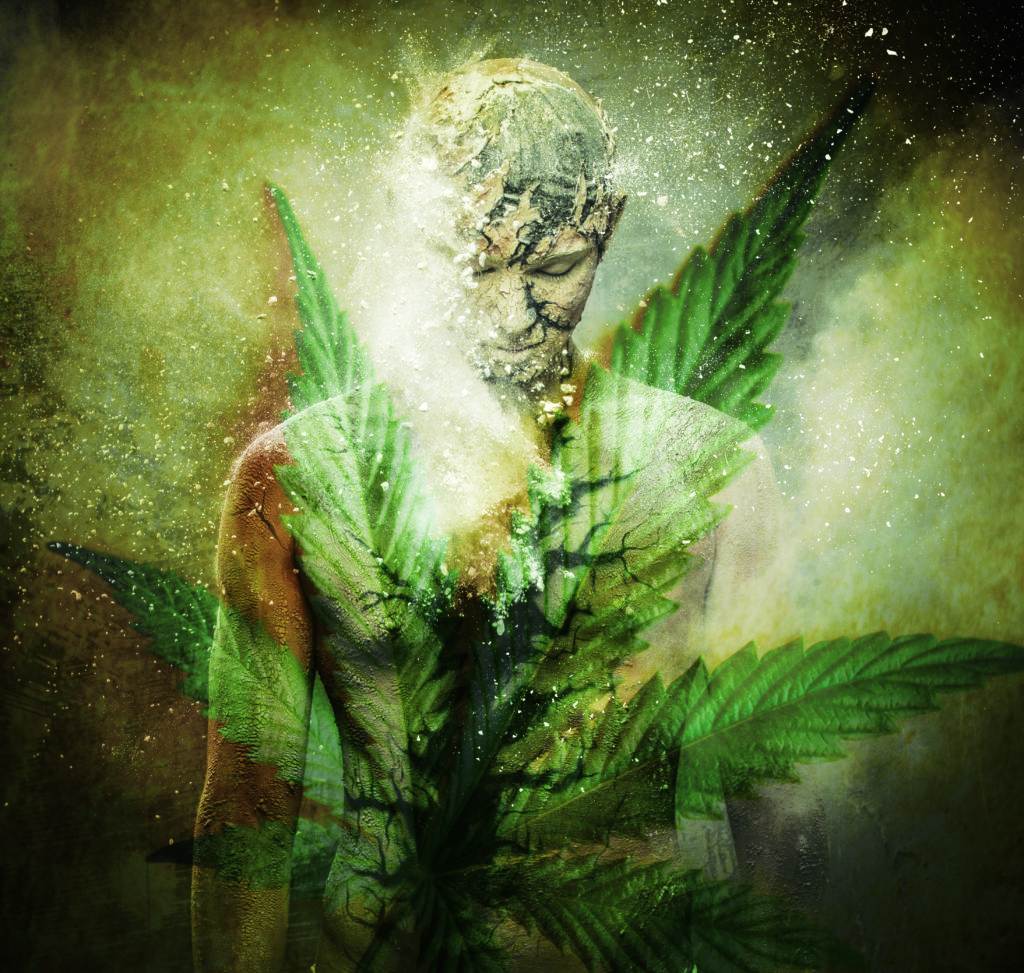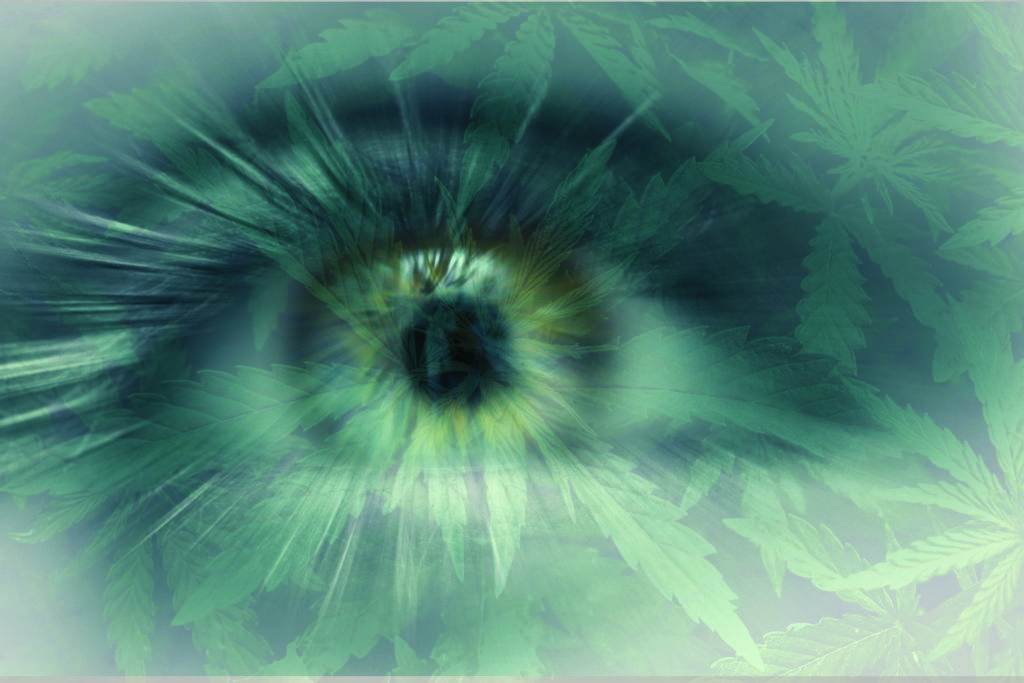Spiritual Friend or Foe in a
New Era of Acceptance?
BY STEPHEN GRAY
Despite sporadic attempts to vilify and banish cannabis over the past couple millennia, this mysterious plant remains one of our oldest and most intimate companions. The Cannabaceae lineage is estimated to be between 30 and 90 million years old, while the plant itself appears in archaeological records from the dawn of civilization. Now Prop. 64 becomes reality for Californians as the state joins 6 others and the District of Columbia in adopting legalization for recreational use. Medical use is legal in 30 states. With its profusion of uses, cannabis will always be the people’s plant.
However, with entrepreneurial activity set to hyperdrive and secondhand smoke ubiquitous on urban street corners, the use of pot as a spiritual ally is still poorly understood, much less practiced. Spiritual ally? For many that’s a controversial claim, but this isn’t just the woo-woo notion of an enthusiastic stoner. Cannabis in ritual and religion has a verifiably ancient and widespread history. Plant residue and smoking paraphernalia have been found in the gravesites of shamans of the Neolithic era roughly 7,500 years ago. Related uses of cannabis appear in some of our earliest written records from 1,500 to 2,000 years BCE. We now know that its spiritual and shamanic use has a long history in various parts of Asia, the Middle East, Africa, and the Americas.
How can these supposed spiritual capabilities be attributed to a plant best known as a gentle euphoric, a frequent instigator of silliness and spaciness, a distracting entertainer, an escape agent, or a trickster capable of seducing people down a dysfunctional rabbit hole? Those who have undertaken an exploration of cannabis for spiritual use understand it as a potential spiritual medicine that may open some doors—not provide a shortcut to the Promised Land. The plant has the effect of upping the ante while challenging us to surrender with eyes wide open. Cannabis is a potential ally that can heal or harm in life’s journey. She has something to teach and many pitfalls to avoid.
The term nonspecific amplifier is useful for understanding why the plant’s biochemical energy needs to be channeled skillfully. Immediately after inhalation (different than for oral ingestion) heart rate slightly increases, resulting in an increased flow of blood throughout the organism, deepening breathing and relaxing the oppositional skeletal muscles. The result—not always—is a balanced homeostatic state of relaxed alertness. In this condition, users are temporarily granted a gift of enhanced psychic energy. The amplification can take you further down the path you’re already on. If your intention, consciously or unconsciously, is to escape—be it from emotions, responsibilities, or relationships, cannabis will graciously assist you. The results of such an escape reflex can be ugly and sometimes can become chronic.

In contrast, if your intention is to heal, wake up, and develop deeper compassion and creativity, she may just amplify that intention. In many spiritual traditions, the key to unlocking that potential is presence, and there are techniques to help an aspirant achieve a state of presence, such as basic follow-the-breath type meditation practices. The underlying precept that these traditions point out is that our natural, unconditioned state is one in which we know in our marrow who we are and what’s real. Further, this essence that we know deep inside is obfuscated by the distorting and limiting narratives we’ve created to protect the illusion of a separate self—often referred to as ego. The path, as it is known, takes an aspirant on a gradual shift from reliance on these imaginary and problematic narratives and toward trust in the unconditioned wisdom of now.
Where cannabis comes in is as that nonspecific amplifier. It can—again, skillfully directed—help us relax and open more deeply into an experience that provides a glimpse into the unconditioned state. In that sense it is not a drug but a reality-engendering ally—a friend to be in relationship with. How? The simplest instruction for encouraging the experience of deepened presence is—as the late psychedelic philosopher Terence McKenna put it—to “sit down, shut up, and pay attention.” In relaxed concentration, cannabis can perhaps aid in the healing and awakening work unobstructed by busyness and a wandering mind. If Mr. McKenna’s somewhat crude instruction doesn’t provide enough guidance for channeling the heightened energy, several variations on basic follow-the-breath meditation will help.
As an amplifier, the judicious use of cannabis can also promote the deepening of a variety of more form-based practices. Yoga is a prime example. Though not in all schools of practice, yoga has a historical relationship with ganja, particularly with the Shaivite sadhus of India. Though perhaps opportunistic, gimmicky, and no doubt controversial, “Ganja yoga” is receiving media attention in America and finding an audience.
There’s a lot more to all this than can be covered here: dosages, strains, and methods of intake can all make a significant difference to the outcome. Strains is a big subject and far more complicated than just the simple sativa to indica continuum. Along with perhaps a hundred or more cannabinoids, there are many other chemical constituents in the plant, such as terpenes, that can exert distinct influences.
Method of intake matters too. Many people report meaningful differences between smoking and vaporizing. Oral ingestion introduces a separate set of considerations. While the possibility of overdosing with inhaled cannabis is a definite maybe, ingested cannabis has a far higher ceiling and greater duration. Caution is the watchword, especially with edibles and other concentrated forms.
Getting the dosage right is also key to the successful navigation of the cannabis high. The short version is that the optimal dosage for spiritual work is the dosage you both want and can handle. This can range from a gentle homeopathic nudge to what might be called shamanic doses, where with skill and practice people have testified to having intense (though provisional) experiences of ego dissolution. By “handle” I mean the dosage you absorb whereby you remain relaxed and present without spinning into debilitating head traffic. If you find yourself falling into the grip of discomforting, disorienting, or fearful symptoms, that’s overdosing.
“Less is more” is a handy concept for working with optimal dosage. For the inexperienced and sensitive, “less” may mean a lot less than you think, especially with commercially produced pot and its high THC concentrations. The “less” principle also refers to frequency of use. Frequency is a complicated subject, and I don’t mean to judge anyone’s patterns of use if they feel it’s working for them—with medical conditions being the prime examples. There are plenty of intelligent, mature, fully engaged adults for whom a light effect from daily use seems to settle them down into a condition of homeostatic balance. You might call that microdosing—a current subject of interest with several entheogens—and label it under a broad definition of medical use. The point is that it may allow such people to function more effectively. And who is anyone to judge if such usage improves people’s lives?
But experienced practitioners know that for spiritual work, the tolerance effect of heavy use of the herb significantly mitigates the potential for sharp, deep work. As shaman Mariano da Silva wrote, “It’s a transcendental effect that really opens your mind, enhances your perception, softens your heart, calms you down, and facilitates a kind of interaction. . . . But if I use it every day I don’t feel this kind of effect from it anymore.”
Segue to addiction-dependence: first, cannabis is not a replacement for an ongoing mindfulness/awareness practice. Peak experiences wear off quickly. What we’re doing is retraining ourselves to relax into the present, to open our hearts and trust the wisdom of the mind-body altogether without the crutch of living life through fixed, ego-protecting concepts and beliefs.

Second, there’s a powerful temptation to keep looking to cannabis for one’s spiritual experiences and sense enhancement. This just won’t work in the long run. Also, it can just become an all-too-cozy cave to escape into. But while true physiological addiction is minimal, psychological dependence can be intense and serious. Tapping into an amplified state of relaxed and alert homeostasis tends to encourage integrating that natural mind-body state into the daily walk, but let the record show that depending on cannabis for those sacred experiences can have regrettably damaging reverse effects.
There are other cautions I can only skim here. One that’s of great concern to parents is that pot use, especially heavy use, can damage the developing adolescent brain. This is a tough one. As Dr. Staci Gruber of Harvard Medical School put it, “The brain is still under construction.” While there is some disagreement in scientific research on the long-term damage caused by heavy cannabis use in adolescents, a number of carefully designed studies conducted over time with large populations and controlled for other influencing factors clearly show distinct deficits in executive function among adolescent heavy users. Importantly, Dr. Gruber’s work also showed that impairment was twice as severe among “heavy, regular marijuana users” who began before the age of 16.
In a post Prop. 64 California, it is unclear how youth will adjust but common sense screams “better safe than sorry!” Yes, it will be illegal to sell marijuana to minors, and minors found dealing or in mere possession will confront a range of consequences, but has prohibition ever been an effective deterrent? What will deter adolescent use?
Suffice it to say there are many very serious concerns for parents raising teens—far too many to address here. One is that young people are highly sensitive during those years; they’re vulnerable, struggling to find an identity. The emotional brain tends to run ahead of the frontal lobes’ rational functions that are still not fully developed. Cannabis can amplify anything. Self-sabotaging ideation can be exaggerated out of all perspective. That is the probable explanation for why the research suggests that while cannabis use may not cause schizophrenia, it can hasten its onset.
Then there’s the temptation = seduction problem. Who wouldn’t want to repeat a pleasurable experience? But that can backfire and become an acute problem for adolescents. As ethnobotanist and sacramental plant wisdom elder Kathleen Harrison described it, “Some people don’t want to come out of the stoned state. . . . They get stuck in the ease of being high, ‘safely’ removed from the daylight world of responsibility and emotional engagement. . . . So many young and not-so-young men are basically wedded to cannabis. It is their primary relationship.”
While it’s important to address cautions around the use of this unorthodox medicine, the contemporary paradigm around cannabis—the new regime, so to speak—with its relaxed, destigmatized laws, is also opening exciting possibilities for understanding the benefits and challenges of working with it as an ally. There are open secrets to be discovered, with much to be learned as the ancient people’s plant settles into its proper place in the human adventure. May we proceed cautiously with open minds and open hearts.
Stephen Gray is an author, educator, speaker, and event organizer. He’s the author of Returning to Sacred World (John Hunt Publishing) and editor/contributor of Cannabis and Spirituality: An Explorer’s Guide to an Ancient Plant Spirit Ally (Inner Traditions / Park Street Press). Find him on Facebook (Cannabis and Spirituality) and at CannabisAndSpirituality.com.